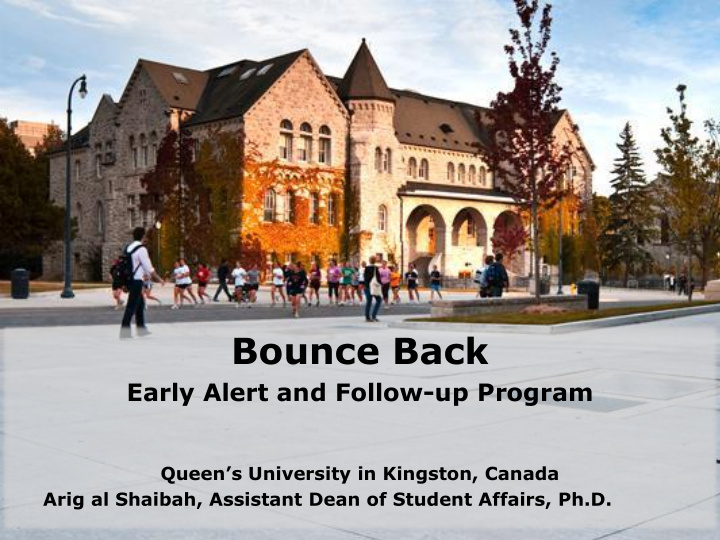



Bounce Back Early Alert and Follow-up Program Queen‟s University in Kingston, Canada Arig al Shaibah, Assistant Dean of Student Affairs, Ph.D.
Session Outline Case for Early Alert Assessment Program Early Alert on your and Questions Overview Program Campus Findings
Queen‟s Context
The Case for an Early Alert Program
Principal‟s Commission on MH University-age highest risk for mental health problems NCHA (2013) undergraduate results MH and academic success 35% 31% 30% 25% 21% 20% 13% 15% 10% 5% 0% Stress Anxiety and sleep Depression difficulties
Lack of Preparedness/Confidence Evidenced in… • Self-reported feedback on orientation and transition surveys • High rates of participation in summer orientation day • Interest in fall First Year Seminar transition program
Purpose To support the persistence and progression of first year students while protecting the quality of their student experience by: 1. Identifying first year students at risk academically and reaching out to provide early intervention 2. Identifying and responding to personal/mental health issues affecting student engagement and academic success
Intervention Model Effective retention programs are intrusive and intentional Bounce Back
Program Concept and Support Based on University of Guelph model Carleton University also adapted Guelph model – Donor supported in first two years Jack Project major sponsor –
Academic and MH Risk Academic Risk Distress/Mental Illness BOUNCE BACK INTERVENTION
Considering Early Alert Program Early Alert…hmm m?
Program Overview
Key Program Elements • Peer-centered approach • Professional staff leadership • Two periods of intake (fall/winter) • Centralized (DSA/SASS) with cross-campus collaboration • Focus on academic support + identifying/referring for MH
Bounce Back Facilitators (BBFs) The Team • 40+ student staff • Minimum 3 rd year • Experience “bouncing back” • 24hrs of training Peer-Based Academic Support • 1 st year UG students • All disciplines • “At risk” academically • 1:1 weekly meetings Anna, BBF MA „15
Senior BBFs Two-tiered structure • Additional 6hrs training Leadership - Group facilitation - • Lead team meetings • Program promotion • Program Outreach April, BBF BEd „15
BBF Supervision & Support Buck, BBF Rugby player BA „15 Professional Network: • Program Coordinator • Senior Learning Strategist • Imbedded Outreach Counsellors • Faculty/School Academic Liaisons
BBF Training Components Mentoring Relationships Learning Campus Strategies Resources (getting unstuck) Physical & Mental Health
eRezLife – BBF Mentoring Logs
Early Alert on your Campus
Early Alert Program Models? What do your interventions with academically “at - risk” students look like? How is student participation/uptake maximized?
Assessment and Findings
Assessment Plan and Tools Participant Intake Survey Study Skills and Habits Questionnaire eRezLife BBF Mentor Logs *Analysis of Grades (GPA) and Retention Rates *Post-Program Evaluations *Contrasted with eligible non-participants
Eligibility and Implementation ARTS & SCIENCE ENGINEERING • GPA < 1.6 • GPA < 1.6 • Mentors - 25 • Mentors - 6 • Senior Mentors - 5 • Intake – Fall & Winter • Intake - Winter NURSING COMMERCE • GPA < 1.6 • GPA < 1.6 or 1 failed course • Mentors - 6 • Mentors - 6 • Intake – Fall & Winter • Intake – Fall & Winter
Profile of Eligible Students Arts & Science – Pilot Year Queen’s First Year ArtSci Cohort Bounce Back Pilot Year 2013-2014 2013-2014 2649 Students 262 Eligible 68% F 32% M 75% F 25% M 2% 6% 17% 1% 82% 92% First Generation First Generation Aboriginal Aboriginal Non-Aboriginal/Non-First Generation Student Cohort Non-Aboriginal/Non-First Generation Student Cohort
Uptake Arts & Science – Pilot Year 4 in 10 eligible students opted in
Findings – Change in GPA Arts & Science Pilot Year *Statistically significant 1.40 1.4 1.20 1.08 1.2 0.99 1 +0.21 +0.32 0.8 0.6 0.4 0.2 0 Participants Eligible Non-Participants Mid-year Year-end
Findings – Retention Rate Arts & Science Pilot Year 100.0% 90.0% +11.3% 80.0% *Statistically significant 66.3% 70.0% 60.0% 55.0% 50.0% 40.0% 30.0% 20.0% 10.0% 0.0% Participants Eligible Non-Participants
Self-Reported Post-Program Results Pilot Year Greater… • levels of resilience, awareness of resources and supports • willingness to use resources and supports • ability to manage their mental health More… • belief they could be successful at university • satisfaction with their university life/experience • frequent use of learning strategies services, academic advising, and writing Considerably more… • confidence in writing winter term exams and papers • satisfaction with their winter term grades
Year 2 Preliminary Data Nursing, Engineering, Commerce Nursing Engineering Commerce • Fall – 21 (57%) • Fall – 69 (23%) • Fall – 65 (0)* • Winter – 14 (TBD) • Winter – 24 (TBD) • Winter – 28 (TBD) • Academic Advising • J-Section • Academic Advising • Tutoring
Lessons Learned (Year 1) Enablers/Successes 1. Relationships with Faculties/Schools 2. Relationships with peer student groups 3. Mentors who have „bounced back‟ 4. Peer-to-peer promotion Challenges/Issues 1. Uptake from most „at - risk‟ students
Lessons Learning (Year 2) Challenges Enablers/Successes 1. Individualized outreach from mentors to most “at - risk” students (< 0.7) Challenges/Issues 1. Early alert for fall mid-term 2. Intensive nature of COMM/ENG/NURS 3. ENG – ↑ incidence of mental health issues 4. ArtSci – ↑ number of international students
Questions and Next Steps Three things you learned Two things you want to explore further One thing you want to do
Contacts Arig al Shaibah arig.alshaibah@queensu.ca Cassandra Eberhardt cassandra.eberhardt@queensu.ca
Recommend
More recommend